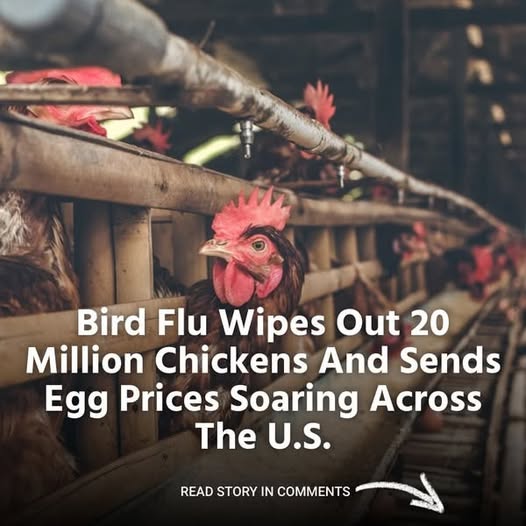The price of eggs in the United States has surged dramatically due to a severe outbreak of avian flu, which has already resulted in the culling of over 20 million egg-laying chickens. This crisis has significantly disrupted the supply chain, causing a nationwide shortage and sending prices soaring. The sudden impact of a single outbreak on the entire system highlights just how fragile food production can be.

The highly contagious bird flu has devastated poultry farms across the country, forcing authorities to take drastic measures to contain the spread. With millions of birds being culled, egg supplies have dwindled, creating an imbalance between supply and demand. As a result, consumers are now facing unusually high prices at grocery stores, and businesses that rely on eggs are struggling to keep up with rising costs.
How the Bird Flu Outbreak Reached This Level
The avian flu, also known as highly pathogenic avian influenza (HPAI), spreads rapidly among birds and is particularly lethal to poultry. Once detected in a flock, the standard protocol is to cull all affected birds immediately to prevent further transmission. This aggressive containment strategy, while necessary to control the outbreak, has led to a staggering loss of egg-laying hens.
According to the U.S. Department of Agriculture (USDA), the virus has impacted all major production systems, affecting both large-scale commercial farms and smaller local operations. This widespread disruption has severely limited the country’s egg supply, creating ripple effects throughout the food industry.
Why Egg Prices Are So Sensitive to Supply Changes
The drastic increase in egg prices underscores the vulnerability of the poultry supply chain. Unlike some agricultural products that can be stored for long periods, eggs are produced on a continuous cycle, meaning any sudden reduction in production can lead to immediate shortages.
In a stable market, the balance between supply and demand keeps prices relatively steady. However, when millions of egg-laying chickens are lost in a short time, supply drops sharply while demand remains constant. This creates an imbalance, forcing prices to rise.
Another challenge is the time it takes to recover from such an outbreak. Poultry farms must go through extensive cleaning and disinfection procedures before they can introduce new flocks. Additionally, it takes several months for young hens to reach maturity and begin laying eggs. These delays further extend the period of high prices and limited supply.
The Consumer Impact and Business Struggles
For everyday consumers, the rising cost of eggs has become an unwelcome burden. Just a year ago, prices had finally stabilized after a previous bird flu outbreak, but now they are climbing again, leaving many households searching for alternatives. Some consumers have cut back on egg consumption, while others have turned to local farms or farmers’ markets in hopes of finding more affordable options.
Food businesses that depend on eggs, such as bakeries, restaurants, and food manufacturers, are also feeling the strain. Many have been forced to adjust their pricing, pass costs onto customers, or modify their recipes to reduce egg usage. The economic impact extends beyond just the grocery store, affecting multiple sectors that rely on eggs as a key ingredient.
USDA’s Response and Efforts to Contain the Spread
The USDA and other agricultural agencies have been working tirelessly to control the outbreak. They have urged poultry farmers to implement stricter biosecurity measures, such as limiting contact between farmed and wild birds, sanitizing equipment, and monitoring flocks for early signs of infection.
Despite these efforts, preventing the spread of avian flu remains a significant challenge. The virus is primarily carried by wild birds, which makes it difficult to stop entirely. Even with strict measures in place, there is always a risk of new infections emerging, leading to further losses and continued price volatility.
The Larger Issue: Food Supply Vulnerability
This crisis has exposed the fragility of the U.S. food supply chain. While food production in the country is generally reliable, events like disease outbreaks, extreme weather, and supply chain disruptions can have an outsized impact on staple products.
Experts argue that more investment is needed in developing better disease prevention strategies, such as improving vaccine development for poultry and implementing stronger biosecurity protocols. Others suggest that diversifying the poultry industry, reducing reliance on massive factory farms, and supporting local egg producers could help build a more resilient system.
What’s Next for Egg Prices?
As the industry works to recover, egg prices are expected to remain high for the foreseeable future. Restoring production levels will take time, and until then, consumers will need to brace for continued fluctuations in price and availability. Some analysts predict that prices will stabilize within the next six to twelve months, but much depends on whether the outbreak can be fully contained.
For now, the best strategy for consumers is to stay informed, seek out alternative sources when possible, and be prepared for ongoing price adjustments. While this crisis highlights the unpredictability of food production, it also underscores the importance of finding long-term solutions to prevent similar disruptions in the future.
Final Thoughts
The bird flu outbreak has delivered a harsh lesson about the vulnerabilities in the food supply chain. The loss of 20 million egg-laying chickens has sent shockwaves through the market, driving up prices and straining both consumers and businesses. As efforts to contain the virus continue, the situation serves as a reminder that even a single outbreak can have far-reaching consequences.
Moving forward, industry leaders and policymakers must work together to create a more resilient food system—one that can withstand these challenges and ensure that essential products like eggs remain accessible and affordable. Until then, Americans will have to navigate the uncertainty, hoping for a swift recovery and a more stable future for egg production.





